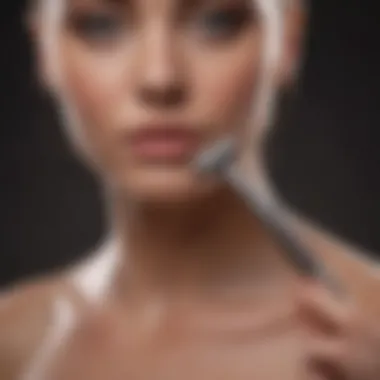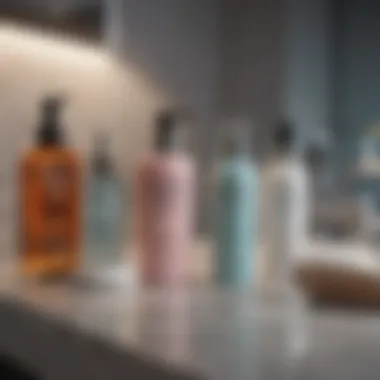The Ultimate Shaving Guide for Women


Intro
Shaving is a fundamental aspect of personal grooming for many women. It can sometimes feel like a daunting task, especially with the variety of techniques and tools available. This guide aims to simplify that process by offering detailed information on techniques, tools, and aftercare. Understanding one’s hair type and skin sensitivity is crucial, as it enables women to choose the right approach to shaving.
Beauty Tips and Tricks
Skincare Routine Tips
Prior to shaving, establishing an effective skincare regimen is essential. Start with exfoliation to remove dead skin cells, which can help prevent ingrown hairs and enhance the shaving experience.
- Exfoliate: Use a gentle scrub suitable for your skin type. This should be done about two to three times a week, depending on sensitivity.
- Moisturize: Apply a hydrating lotion or cream after exfoliation and before shaving. This keeps the skin supple and minimizes irritation.
- Use Warm Water: A warm shower or bath can soften hair and open pores, creating an ideal environment for shaving.
Haircare Hacks
Although shaving is focused on body hair removal, understanding how to manage hair growth can have positive effects on skin health. Here are some tips:
- Avoid heavy oils or creams before shaving, as these can make it difficult for a razor to glide efficiently.
- If thicker hair is a concern, consider trimming before shaving. This step can ensure a smoother shave by preventing clogging of the razor.
Makeup Application Techniques
Post-shaving, the skin can be more sensitive. Choosing suitable makeup products can help:
- Use hypoallergenic makeup to reduce the possibility of irritations.
- Avoid heavy foundations immediately after shaving; instead, opt for a lightweight tinted moisturizer.
Expert Beauty Advice
Professional Makeup Artist Insights
Makeup artists often stress the importance of clean skin as a canvas. After shaving, they suggest applying a soothing serum or gel to calm any redness. Look for products containing ingredients like aloe vera or chamomile.
Skincare Specialist Recommendations
Skincare professionals often recommend waiting at least 24 hours post-shave before applying any new products. This allows the skin to recover properly. When introducing new items, patch testing is advised to ensure no adverse reactions occur.
Hair Stylist Tips
Hair experts note the importance of maintaining the area where hair has been removed. Regular trimming and exfoliation can lead to a more polished look. If styling is needed, they recommend using light products that won’t weigh the hair down while also nourishing the skin.
"Proper aftercare is as important as the shave itself. Keeping the skin healthy leads to better results in the long run." – Expert Beauty Specialist
End
Understanding the intricacies of shaving for women is vital for achieving desirable results. Paying attention to skin type, shaving tools, techniques, and aftercare can significantly improve the experience and outcome. This guide serves as a tool for enhancing one's beauty routine through effective shaving practices.
Understanding the Basics of Shaving
Shaving is a common practice for many women, yet it is essential to grasp the fundamental aspects of this activity. Understanding the basics ensures not only effective hair removal but also care for skin health. Knowledge of the various methods and techniques can contribute to a smoother experience and better outcomes. One must consider factors like skin type and hair thickness, as these influence the choice of tools and techniques.
The Purpose of Shaving
The primary purpose of shaving for women usually centers around personal preference and aesthetics. Many women choose to shave for reasons such as:
- Hygiene: Some feel cleaner and more comfortable without body hair.
- Aesthetics: Smooth, hair-free skin can align with personal beauty standards.
- Convenience: Shaving can be quicker than other hair removal methods and easily done at home.
For some, shaving is also an integral part of their beauty routine, contributing not only to appearance but also to self-esteem.
Different Shaving Methods
Choosing the right shaving method is crucial for achieving the desired results while minimizing skin irritation. Each method has distinct characteristics and can be advantageous or disadvantageous depending on individual needs.
Dry shaving
Dry shaving refers to shaving without any additional moisture or shaving products. It is easy and convenient, making it a popular choice for many women.
- Key Characteristic: No water or gels are needed, allowing for quick touch-ups.
- Benefits: It can be efficient if time is limited or for immediate grooming needs.
- Drawbacks: However, it can lead to irritation or a less smooth finish compared to other methods. Dry shaving often exposes the skin to more friction and irritation, especially for those with sensitive skin.
Wet shaving
Wet shaving involves using water and shaving products like creams or gels. This method is well-known for its benefits to skin health.
- Key Characteristic: The use of moisture softens hair and skin, resulting in a closer shave.
- Benefits: This method minimizes irritation, allowing for a smoother finish and reducing the risk of cuts. It is recommended for women seeking a thorough shave with enhanced comfort.
- Drawbacks: A downside may include needing more time to properly prepare. Additionally, there is a requirement for additional products, which could complicate the process.


Electric shaving
Electric shaving involves the use of battery-powered or corded devices. This method varies widely in functionality and design, catering to diverse preferences among women.
- Key Characteristic: Electric shavers can be designed for dry or wet use.
- Benefits: They offer convenience and speed. For many, electric shavers can reduce the risk of cuts and nicks.
- Drawbacks: However, some users might find that electric shaves do not provide as close a shave as manual methods. Selecting the right electric shaver is also critical, as different devices can yield varying results.
In summary, understanding the basics of shaving equips women with the knowledge needed to choose the method that best suits their personal needs and preferences.
Choosing the Right Tools
Selecting the right tools for shaving is crucial for achieving the best results while minimizing skin irritation. Different tools serve distinct purposes, affecting the efficiency and smoothness of the shave. It is essential to invest time in understanding the available options and their benefits. Furthermore, the right tools can also enhance the overall shaving experience, making it more enjoyable and effective.
Razors: Safety, Cartridge, and Disposable
When it come to razors, there are three main types: safety, cartridge, and disposable. Each type has unique features that cater to different skin sensitivities and preferences.
- Safety Razors: These are preferred by many for their effectiveness and eco-friendliness. They typically use double-edged blades, which can provide a close shave. This type also allows for less waste since you only replace the blades. However, they require some skill to use properly and to avoid cuts.
- Cartridge Razors: These are widely used due to their convenience and availability. They come with multiple blades in a single cartridge, which can offer a smoother shave with fewer passes. Often, these razors have a lubricating strip to help reduce irritation. However, they can generate more waste, as the entire cartridge is disposed of after use.
- Disposable Razors: Ideal for travel or for a quick shave, these are economical and easy to use. They are often equipped with fewer features and may not provide as smooth a shave as other options. For those who shave infrequently, they can be a practical choice but may not be as environmentally friendly.
Choosing the right razor depends on your personal shaving habits, desired results, and sensitivity of your skin. Each type has unique advantages but also potential drawbacks.
Foams and Gels Explained
The choice of shaving foam or gel also significantly impacts the shaving process. These products create a protective barrier between the skin and the razor, resulting in a smoother shave with less irritation.
- Shaving Creams or Gels: Thick formulations often provide better lubrication, making it easier for the razor to glide over the skin. This can reduce the risk of nicks and cuts. Depending on individual skin types, options are available for sensitive skin or those prone to allergies.
- Foams: Generally lighter than creams, shaving foams can be effective for many users seeking a quick, uncomplicated shave. They often contain air to create volume, which can be appealing in terms of application but may not provide as much hydration as gels.
- Natural and Organic Options: Increasingly popular, these products are formulated with fewer synthetic ingredients. They may offer significant benefits for sensitive skin, minimizing reactions while still providing effective lubrication.
Ultimately, the choice between foams and gels depends on personal comfort and results. Experimenting with different types may help in finding the right match for your skin.
Finding the Best Aftercare Products
Post-shaving care is vital for maintaining skin health and comfort. The right aftercare products can soothe irritation, hydrate the skin, and prevent post-shave problems.
- Moisturizers: Look for aftershave balms or lotions that provide hydration. Ingredients like aloe vera and chamomile are soothing and can help calm the skin. Applying these products immediately after shaving can reduce redness and irritation.
- Antiseptic Wipes or Creams: If you are prone to cuts or other irritations, applying a mild antiseptic can prevent infection and promote healing.
- Exfoliating Products: Using a gentle exfoliator once or twice a week can help prevent ingrown hairs, a common issue many face after shaving. Look for products that are suitable for your skin type to ensure they do not cause further irritation.
Preparing for a Shave
Preparing for a shave is a crucial step in the shaving process that can significantly impact the outcome. Proper preparation is essential not just for achieving a smooth finish, but also for minimizing irritation and ensuring overall skin health. There are several key elements to consider when preparing for a shave, including skin preparation techniques and the timing of the shave itself. Each helps create an ideal environment for shaving. Without attention to these details, even the best tools and products may not deliver the desired results.
Skin Preparation Techniques
Skin preparation techniques are vital for creating the best conditions for shaving. The skin holds the most importance first. Properly addressed skin can reduce the risk of cuts, bumps, and ingrown hairs. Here are some techniques to consider before shaving:
- Exfoliation: Gently exfoliate the skin a day or two before shaving. This helps remove dead skin cells, allowing for a closer shave.
- Cleansing: Clean the area you plan to shave with a mild soap or cleanser. Dirt and oil can hinder the effectiveness of your shaving tool and lead to irritation.
- Hydration: It's crucial to hydrate the skin. This can be done with water or by using a pre-shave oil or lotion. Hydrated skin is more pliable and less likely to become irritated during shaving.
Using these techniques ensures that the skin surface is prepared adequately. They promote better razor performance and help prevent potential post-shaving issues. Emphasizing skin preparation should not be overlooked for an enjoyable shaving experience.
Choosing the Right Time to Shave
The timing of a shave can dramatically affect results. Factors like skin sensitivity and hair growth cycles play a role in determining the optimal time. Here are important considerations:
- Post-Shower: Shaving after a warm shower is often recommended. The warm water helps soften hair and open pores, making the shave more effective.
- Time of Day: Many find that shaving in the morning is advantageous. Skin is typically less sensitive after a good night's rest. Conversely, evening shaving can allow for recovery and moisturization overnight.
- Frequency: Consider how often to shave. The ideal frequency varies by hair type and personal preference. Some may need to shave daily, while others may do so weekly.
"Choosing the right time to shave is just as essential as the technique used during the process."
In summary, preparing for a shave involves more than just picking up a razor. It's about adopting a systematic approach that considers skin health and making informed decisions about timing. Ensuring well-prepared skin and selecting the right moment can deeply enhance the overall experience of shaving for women.
Shaving Techniques for Different Areas
Understanding shaving techniques for different areas is more than just a methodical approach; it impacts the overall experience and outcome of shaving for women. Each area of the body has unique characteristics and hair types that may require specialized care. Proper techniques not only pave the way for smoother skin but also help to avoid common pitfalls such as irritation and nicks. Hence, knowing the best approaches for various body areas can empower women to feel confident and beautiful, regardless of their hair removal choices.
Leg Shaving
Technique for Smooth Legs
The technique for achieving smooth legs includes several key practices that can enhance the shaving experience. Using a sharp, clean razor is essential; it reduces the risk of cuts and allows for a closer shave. Preparation is crucial—exfoliating the skin prior to shaving helps to remove dead skin cells and enable the razor to glide effortlessly. A moisturizing shaving cream or gel provides lubrication, making it easier for the razor to move along the skin. This technique not only results in a more polished finish but also reduces the chances of ingrown hairs.
Unique to this technique is the importance of shaving in the shower or after bathing, as the warm water softens the hair and opens up pores. The primary advantage is that this method leads to longer-lasting smoothness and reduces irritation, which can be a common concern during leg shaving. Although the approach is straightforward, attention to detail during each step can greatly influence the effectiveness of the shave.
Common Mistakes
Common mistakes made during leg shaving often stem from haste or a lack of preparation. A prevalent issue is the use of dull razors, which can snag at the hair and create a painful experience. Skipping exfoliation is another pitfall; it can lead to clogged razors and unsatisfactory results. Furthermore, shaving against the direction of hair growth can contribute to irritation and ingrown hairs.
Being aware of these mistakes allows for a more mindful approach to leg shaving. The unique aspect of understanding typical errors is that it empowers women to adjust their techniques proactively. Addressing these oversights not only enhances the outcome of the shave but also promotes skin health in the long term.


Underarm Shaving
Positioning and Technique
Positioning and technique play a vital role in achieving effective underarm shaving. The underarm area features sensitive skin and frequent movement, demanding careful handling. To ensure a close shave, it is advisable to lift the arm to create a taut surface. Opting for a gentle razor designed for sensitive skin can help mitigate risks of irritation.
This technique emphasizes slow strokes and minimal pressure to prevent cuts. An important benefit of this method is that it allows for better maneuverability around the contours of the armpit, aiding in a cleaner result. Ultimately, taking the time to adopt a proper position translates into a smoother, irritation-free experience.
Dealing with Sensitivity
Dealing with sensitivity in the underarm region can pose challenges. Many women encounter redness or irritation post-shaving. Incorporating products designed for sensitive skin can alleviate discomfort. Additionally, moisturizing the skin before shaving is important. Taking a break from shaving every now and then may also give the skin time to recover, reducing recurring sensitivity issues.
Understanding skin types and what products suit those conditions can lead to successful resolution of sensitivity problems. The uniqueness of this challenge lies in its commonality among women, making the sharing of practical solutions vital for improving everyone's shaving routine.
Bikini Area Shaving
Techniques for Sensitive Skin
When shaving the bikini area, special attention must be paid to techniques for sensitive skin. The bikini line is often delicate, with thin skin that can easily become irritated. One effective method includes using a sharp razor while ensuring that a quality shaving cream formulated for sensitive skin is applied liberally. This practice not only protects the skin but also enhances the shaving experience by minimizing friction.
Additionally, using stencils or trimmers before shaving may help to define the desired areas without causing too much irritation. This technique is popular due to its ability to create cleaner lines without compromising skin comfort. The focus on sensitive areas calls for the use of specific products that prioritize hydration and gentleness, ensuring both safety and satisfaction.
Aftercare Recommendations
Aftercare is equally important following bikini area shaving. Applying soothing lotions or aloe vera gel can help minimize irritation and provide hydration. Avoiding tight clothing for a short period post-shaving also aids in skin recovery by reducing friction.
The key feature of proper aftercare is its potential to prevent long-term issues such as rashes or ingrown hairs. Creating an aftercare routine can significantly improve the overall experience of shaving in sensitive areas, which many women find beneficial. Implementing these strategies ensures that the bikini line remains as smooth and irritation-free as possible.
Successful shaving routines depend largely on understanding specific techniques and addressing unique skin needs. The right approach can transform an everyday task into an enjoyable experience.
Post-Shaving Care
Post-shaving care is an essential component of achieving smooth and healthy skin. Many women may overlook this step, focusing primarily on the act of shaving itself. However, what happens after the shave can significantly impact the health of the skin and the overall shaving experience. Proper post-shaving care can help prevent irritation, minimize the occurrence of ingrown hairs, and ensure the skin remains hydrated and soft.
A key benefit of post-shaving care is its ability to soothe the skin. Shaving can cause minor abrasions and inflammation, leading to redness and discomfort. By following a thoughtful aftercare routine, you can alleviate these concerns effectively. Additionally, maintaining moisture is crucial. Shaving removes not only hair but also natural oils from the skin, leading to dryness. Using suitable products after shaving can help restore the skin’s moisture barrier, keeping it supple and smooth.
Immediate Aftercare Steps
Immediately after shaving, it is essential to address the skin to promote healing and comfort. Here are some steps to consider:
- Rinse with Cool Water: This helps to remove any remaining hair or shaving cream and close the pores.
- Pat Dry Gently: Avoid rubbing the skin with a towel; instead, pat it dry to prevent any irritation.
- Apply a Soothing Lotion: Look for products containing aloe vera or chamomile. These ingredients can help calm irritation.
- Use an Alcohol-Free Aftershave: Traditional aftershaves often contain alcohol, which can increase dryness. Opt for gentle, alcohol-free options to prevent further irritation.
By implementing these steps instantly after shaving, you can significantly reduce discomfort and enhance the skin’s recovery process.
Long-Term Skin Maintenance
The journey of maintaining skin health does not end immediately after shaving. Incorporating long-term skin maintenance into your routine is equally important. Consider the following approaches:
- Regular Exfoliation: Incorporate gentle exfoliation into your skincare routine to prevent dead skin buildup and reduce the chances of ingrown hairs. Aim for exfoliation 1-2 times per week, using products suitable for your skin type.
- Hydration: Invest in a nourishing moisturizer. This helps replenish the moisture lost during shaving and promotes overall skin health.
- Sun Protection: Always use sunscreen on shaven areas when exposed to sunlight. Newly shaven skin can be more sensitive to UV damage.
- Evaluate Products: Pay attention to how your skin reacts to different moisturizers and lotions. Discontinue use of products that cause irritation.
Maintaining a consistent skin-care regimen will ensure that your skin remains healthy and resilient, enhancing your shaving experience for the future.
"Post-shaving care is not just a step; it's an essential ritual for healthy skin. Ignoring this can lead to discomfort and long-term skin issues."
Addressing Common Concerns
Shaving can raise various concerns for women, making it important to address these issues thoroughly. Understanding the common problems associated with shaving allows individuals to adopt practices that minimize discomfort and maximize effectiveness. This section delves into two key areas: dealing with irritation and ingrown hairs, as well as the myths surrounding shaving. Tackling these challenges can lead to a more confident shaving experience.
Dealing with Irritation and Ingrown Hairs
Skin irritation and ingrown hairs are perhaps the most significant issues women face when shaving. Irritation often occurs due to a combination of factors, including skin sensitivity, razor choice, and shaving techniques. The outcome can range from minor discomfort to visible redness and bumps, which detracts from the smooth skin women aim to achieve.
To combat irritation, it is essential to employ proper shaving techniques. This includes:
- Using a sharp razor: A blunt blade can tug at the hair rather than cutting it cleanly, leading to more irritation.
- Shaving in the direction of hair growth: This can reduce the risk of pulling hair and minimize irritation.
- Utilizing hydration: Wet shaving with gel or cream can provide a protective barrier for the skin. This lubrication allows the razor to glide more smoothly over the skin, lowering the risk of cutting or irritating it.
Ingrown hairs occur when hair curls back into the skin instead of growing outward. This can lead to small painful bumps and, in some cases, infections. To prevent ingrown hairs, consider the following practices:
- Exfoliate regularly: Exfoliating the skin can help remove dead skin cells, allowing hair to grow freely. Incorporate gentle scrubbing or chemical exfoliants to maintain smooth skin.
- Avoid tight clothing post-shave: Tight garments can irritate the skin and cause hair to grow inward.
Shaving Myths Debunked
Understanding the myths associated with shaving is just as crucial as addressing physical concerns. Misconceptions can lead to unnecessary anxiety or incorrect shaving practices.


Some common myths include:
- Myth: Shaving makes hair grow back thicker.
- Myth: You can only shave dry skin.
- Myth: You should shave every day for the best look.
- This is false. Shaving does not affect the hair's thickness or growth rate. It may feel coarser because of the blunt edge of the cut hair.
- In fact, wet shaving is often recommended for better results. Wet techniques can minimize irritation and enhance skin hydration.
- Shaving frequency should be based on personal preference and hair growth rates. Over-shaving can lead to irritation and skin damage.
Understanding these facts—and dispelling myths—helps women approach shaving with confidence and clarity. Choosing effective techniques for their individual skin types and addressing concerns contributes to a smoother, more satisfying shaving experience.
Alternative Hair Removal Methods
In the realm of hair removal, alternative methods to shaving play a significant role. Many individuals seek methods that provide longer-lasting results or cater to specific skin and hair types. Understanding these options can help women make informed choices, tailoring their hair removal practices to suit their needs.
Waxing vs. Shaving
Waxing is often favored for its long-lasting effects. It pulls hair out from the root, which can delay regrowth compared to shaving, which only cuts hair at the surface level. Many women prefer waxing for the following reasons:
- Duration: Waxing can keep skin smooth for three to six weeks, while shaving requires repeated effort every few days or weekly.
- Smoother Finish: Waxing generally produces a smoother finish since it removes hair from the root, leading to fewer coarseness issues.
- Fewer Ingrown Hairs: When performed properly, waxing might reduce the occurrence of ingrown hairs, a common concern with shaving.
However, waxing does involve some down sides. It can be painful, and skin may be sensitive post-procedure. Additionally, it requires hair to be a certain length for effective removal.
Conversely, shaving is often more accessible and less painful. Using a razor can easily adapt to various areas of the body, making it a convenient choice for many women. It enables immediate results without the waiting period associated with hair regrowth from waxing.
Laser Hair Removal Considerations
Laser hair removal offers another method for removing unwanted hair. This technique employs concentrated light to target hair follicles, ultimately leading to reduced hair growth over time.
A few important factors must be considered when exploring laser hair removal:
- Effectiveness: Many individuals notice significant reduction in hair growth after several sessions. This method is most effective on individuals with light skin and dark hair, as the contrast allows the laser to target hair follicles more efficiently.
- Cost: This method can be more expensive than shaving or waxing, as multiple sessions may be required for optimal results.
- Skin Types: Not all skin or hair types are suitable for laser hair removal. Consulting with a professional is essential to determine eligibility and understand any potential risks.
- Pain Level: Although laser hair removal is generally less painful than waxing, some discomfort may still occur during procedures.
In summary, understanding the various methods of hair removal available allows women to choose the best approach that meets their personal preferences, skin types, and lifestyle needs. Keeping in mind the pros and cons of each option ensures an informed decision that aligns with individual grooming goals.
"Choosing the right method for hair removal is crucial for effective results and personal comfort."
Whether a woman prefers waxing, laser treatments, or simply sticking to traditional shaving, knowing the advantages and disadvantages of each method can guide her in maintaining beautiful skin.
Personalizing Your Shaving Routine
Personalizing your shaving routine is critical in achieving not only a smooth shave but also ensuring the health of your skin. Each woman's skin texture and hair type vary significantly. Therefore, understanding your unique characteristics will enable you to select the right techniques and products that suit you best. This will help to minimize irritation and enhance the overall shaving experience.
Understanding Skin and Hair Types
Recognizing your skin and hair type forms the foundation of a customized shaving routine. Skin types can range from oily and dry to sensitive and combination. Different hair types also require distinct approaches; for example, fine hair may not need the same technique as coarse hair.
- Skin Types:
- Hair Types:
- Sensitive Skin: May react to products or shaving methods. A gentler technique is essential.
- Oily Skin: Often requires specific products that can manage oil while providing moisture.
- Dry Skin: Needs moisturizing creams or oils to maintain hydration while shaving.
- Fine Hair: Can be easily shaved; however, using a light touch is necessary.
- Coarse Hair: Requires more powerful tools and perhaps even pre-shaving treatment for easier shaving.
Understanding these factors can greatly enhance your shaving routine. Products can be chosen based on these characteristics, helping to reduce post-shave issues like redness or bumps.
Adjusting Techniques and Products
Once you understand your skin and hair type, you can adjust the techniques and products that best fit your needs. This step involves evaluating both the tools you use and the methods you apply.
- Shaving Technique Adjustments:
- Product Selection Adjustments:
- Angle and Pressure: Use a shallow angle for sensitive skin and adjust pressure accordingly.
- Shave with the Hair: Going with the hair’s growth direction can help prevent skin irritation.
- Exfoliating Beforehand: This can be beneficial for coarse hair, as it removes dead skin cells and prepares the skin.
- Creams and Gels: For someone with oily skin, a foaming gel may be more effective than a cream.
- Aftercare Products: Ingredients like aloe vera or hyaluronic acid are beneficial for hydration after shaving.
Personalizing routines requires experimentation. Pay attention to what works for you and make adjustments as needed. As you develop your routine, the goal is to find a balance that provides a comfortable shave while addressing any unique needs of your skin and hair type.
Epilogue and Final Thoughts
In this comprehensive exploration of shaving for women, it becomes clear that the practice is much more than simply achieving a smoother appearance. It is about understanding the skin and hair dynamics, selecting the appropriate tools, and refining techniques for optimal results. The importance of personalized routines cannot be overstated. Shaving needs to be adapted based on individual skin types, hair textures, and sensitivity levels. This approach not only fosters better skin health but also enhances confidence in personal grooming habits.
Furthermore, the emphasis on post-shaving care as discussed is vital. While achieving smooth skin is often the goal, ensuring the skin remains nourished and hydrated post-shave is equally crucial. Using suitable aftercare products can minimize irritation and prevent common issues like ingrown hairs or rashes. Thus, the relationship between shaving techniques and aftercare aids in maintaining not just aesthetic appeal but also skin wellbeing.
"An informed shaving routine can transform a daily chore into a pleasurable self-care ritual."
The insights provided throughout this guide serve as a practical toolkit for women to traverse the often confusing landscape of shaving. From understanding the basic purposes and methods of shaving to personalizing routines based on one’s unique features, every detail contributes to a richer, more effective experience.
In summary, shaving may appear straightforward, but it involves a careful blend of knowledge, product choice, and self-awareness. The information detailed in this article encourages readers to experiment thoughtfully and develop a routine that suits their lifestyle and skin characteristics. Through dedication to proper techniques and aftercare, every woman can achieve the smooth and healthy skin they desire.







